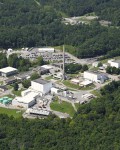If you've ever been stuck in traffic on a hot, sunny afternoon, you might have noticed the rippling effect caused by the release of even hotter exhaust fumes. If so, you've watched opportunity drift away.
Automobiles, power plants, laptops and many other machines produce heat when they operate. Waste heat is an unavoidable energy loss, a tradeoff in order to produce the kind of energy for which the machine is intended. However, this heat could be partly recycled into electrical energy through thermoelectric technology, which converts a temperature difference into an electric voltage.
To understand how to design better thermoelectric materials, researchers are using neutron scattering at the Spallation Neutron Source (SNS) and the High Flux Isotope Reactor (HFIR) at the U.S. Dept. of Energy (DOE)'s Oak Ridge National Laboratory (ORNL) to study how silver antimony telluride is able to effectively prevent heat from propagating through it on the microscopic level. Heat in materials is carried by quantized sound waves, known to scientists as phonons. By mapping the phonons and their interactions with the atomic architecture of silver antimony telluride, researchers in ORNL's Quantum Condensed Matter and Materials Science groups discovered that a complex structure of nanoscale domains improved the thermoelectric properties of this compound. Read more here.




